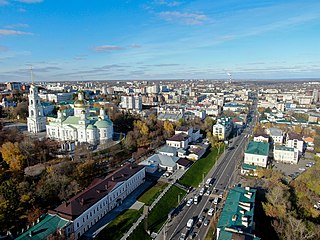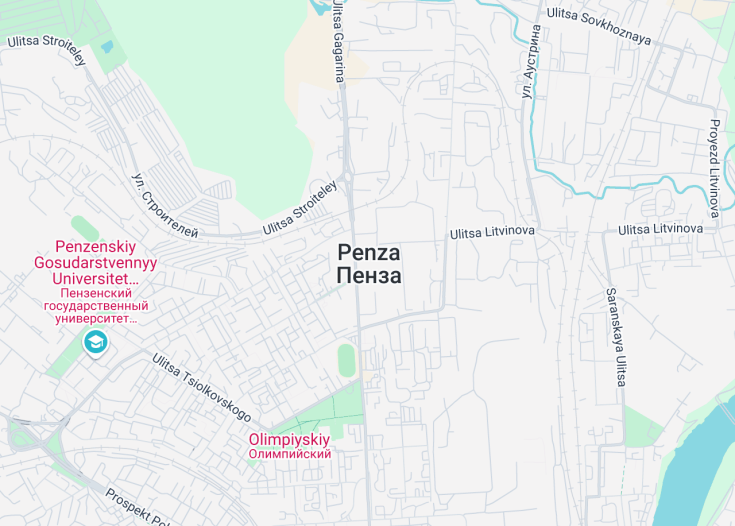Penza, a captivating city in western Russia, stands as a unique blend of historical grandeur and vibrant cultural life. Founded in 1663, this city is steeped in rich history reflected in its buildings, monuments, and museums. From the majestic Spassky Cathedral to the Penza Regional Art Gallery, visitors can explore diverse architectural styles and artistic wealth.
The city is also known for its lush green parks, like Belinsky Central Park, offering respite amidst natural beauty. Penza’s events and festivals, celebrating Russian traditions and modernity, make it an ever-evolving tapestry of cultural experiences, suitable for all ages and interests.
When in Penza, be sure to visit the Lermontov Museum, dedicated to the famous Russian poet Mikhail Lermontov, which offers deep insights into Russia’s literary history and culture.
For a truly local experience, time your visit to coincide with the Penza City Day celebrations in September, filled with parades, music, and traditional festivities.
Top things to do & see in Penza
Select the following sights and activities to discover best tickets and tours available in Penza.
Penza: A Gateway to Russia’s Heartland
| Country | Russia |
| Time in Penza | GMT+3 |
| Language spoken | Russian |
| Population | 520,000 (as of 2023, source: Federal State Statistics Service) |
| Currency | Russian Ruble (₽, RUB) |
| Airports |
|
Penza, the city founded in 1663, serves as the administrative center of Penza Oblast, Russia. Nestled in the southeastern part of the East European Plain, it holds rich historical and cultural heritage. The city originally served as a fortress town on the frontier of the Russian Empire. Over the centuries, it transitioned into a robust industrial and cultural hub.
The city’s architecture is a tapestry of Tsarist-era buildings, Soviet block constructions, and modern edifices, narrating the evolution through ages. Penza is known for its well-preserved theaters and museums, such as the Penza State Theatre of Opera and Ballet and the Savitsky Picture Gallery, housing an impressive collection of Russian art.
On the economic front, Penza is a significant industrial center in the Volga region, particularly noted for its electronic, mechanical engineering, and agricultural machinery industries. The city’s geographical position as a critical junction of rail and road networks underlines its strategic importance in trade and logistics within Russia.
Education is a cornerstone of the city with several higher education institutions, including Penza State University, which attracts students from various parts of Russia and neighboring countries. The blend of historical essence and modern vibrancy makes Penza a unique city with a promising future of opportunities and cultural enrichment.
Where is Penza?
Located in the European part of Russia, Penza lies southeast of Moscow, nestled on the Sura River, enriching the Penza Oblast’s heartland.
Distances:
| Route | Distance by car | Time by car |
|---|---|---|
| Moscow to Penza | 628 km | Approximately 9 hours |
| Saint Petersburg to Penza | 1194 km | Approximately 17 hours |
What is Penza famous for?
Penza is celebrated for its rich cultural heritage and numerous landmarks including the Penza State Opera and Ballet Theater, Lermontov Library, and the Rostok Monument, reflecting its historical significance.
History
1644 – The Founding of Penza
The history of {destination_name} begins in 1644, when it was established as a fortress outpost on the southeastern frontier of Russia. Intended to protect the region from nomadic raids, the growth of Penza was closely tied to its military and strategic importance. Settlers in these early days were primarily soldiers, craftsmen, and farmers given the task of establishing a sustainable community amidst a challenging environment.
1700s – Expansion and Development
Under the Russian Empire, Penza evolved beyond its military blueprint in the 18th century. The development of agriculture, particularly the cultivation of grains and breeding of horses, played a pivotal role. This period also saw the construction of significant religious and civic structures that would define Penza’s architectural heritage, including the Trinity Cathedral.
1800s – Cultural Flourish
The 19th century marked a cultural flourishing in Penza as it became a hub for merchants and intellectuals. Noteworthy is the Penza of this era attracting artists, writers, and thinkers, contributing to a rich cultural tapestry. By the mid-1800s, Penza established itself not just as an agricultural centre but also as a significant cultural and educational spot in Russia.
1900s – Revolutionary Changes to Modern Times
The tumultuous events of the 20th century, including the Russian Revolution and World War II, brought significant changes to Penza. Post-1917, it became a part of the burgeoning Soviet Union. This era saw industrial growth, with development in manufacturing sectors and the establishment of heavy machinery plants. Penza also became a key site during World War II for evacuated factories and personnel. The city continued to develop its industrial base during the post-war Soviet era and into modern Russia. Current Penza is known for its role in electronics, engineering, and the pharmaceutical industry, maintaining its place in the national economic landscape.
Visit Penza
What to see and do in Penza, Russia
Exploring {destination_name} offers a blend of historical, cultural, and natural attractions. Notable sites include the Penza Art Gallery, housing an impressive collection of Russian and European art, and the Belinsky Park, a perfect spot for leisurely walks and family outings.
For those interested in history, the Penza Regional Museum provides insights into the local heritage. Additionally, the city’s well-preserved architectural landmarks like the Trinity Cathedral and the Lermontov Theatre offer glimpses into its past.
Festivals and Celebrations in Penza
{destination_name} boasts a variety of cultural events throughout the year. The Penza Jazz Festival, typically held in autumn, showcases local and international artists, while the Spring Festival celebrates the end of winter with music, dance, and traditional foods. These events provide a lively, festive atmosphere and a deep dive into the local culture and traditions.
Best time to visit Penza
The best times to visit {destination_name} are late spring (May and June) and early autumn (September and October). During these months, the weather is pleasantly mild, and the city’s parks and gardens are in full bloom, creating a beautiful backdrop for sightseeing and outdoor activities.
Is Penza worth visiting?
Penza offers a unique mix of historical depth, cultural richness, and natural beauty, making it a worthwhile destination for those interested in Russian history and culture. While it may not boast the same level of fame as Moscow or Saint Petersburg, its quieter charm and less crowded attractions provide a more relaxed experience.
However, visitors should be prepared for its relatively colder climate and a less developed tourism infrastructure compared to Russia’s larger cities.










